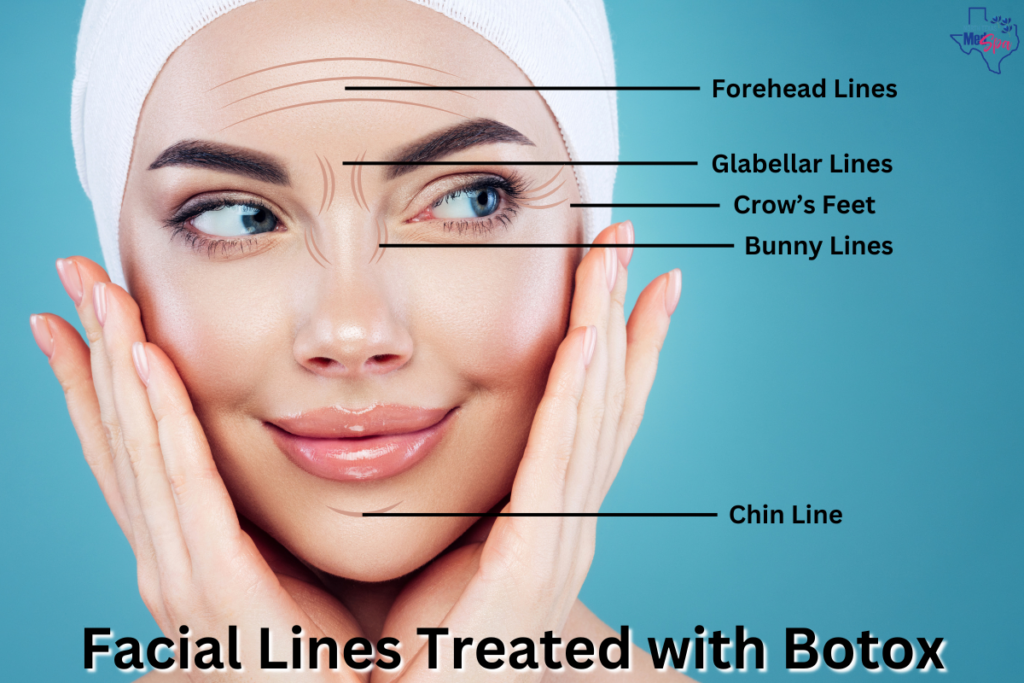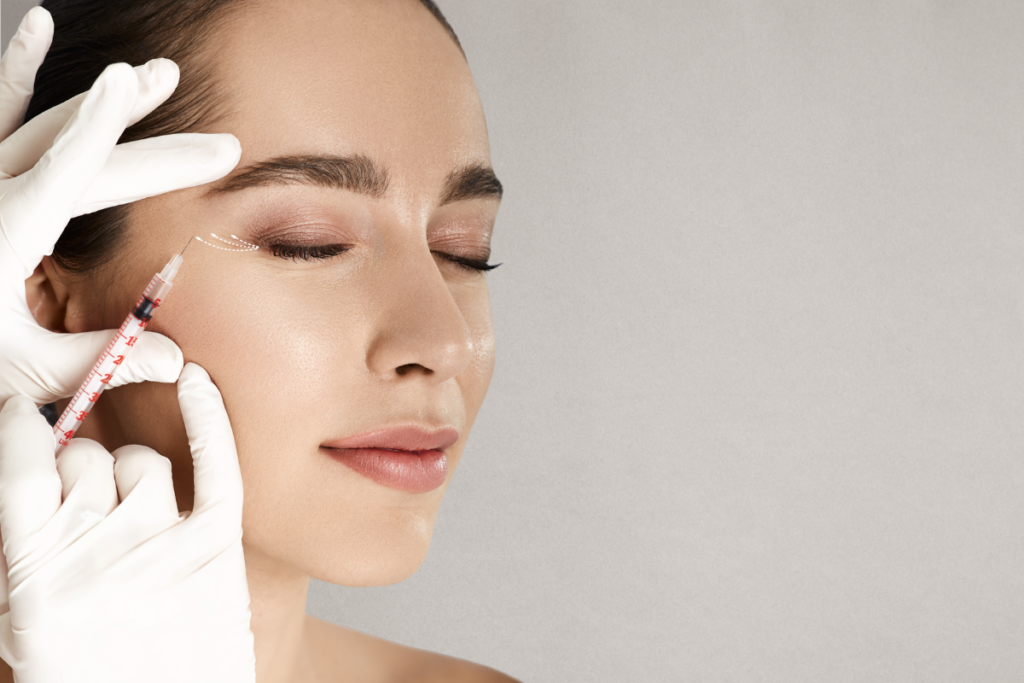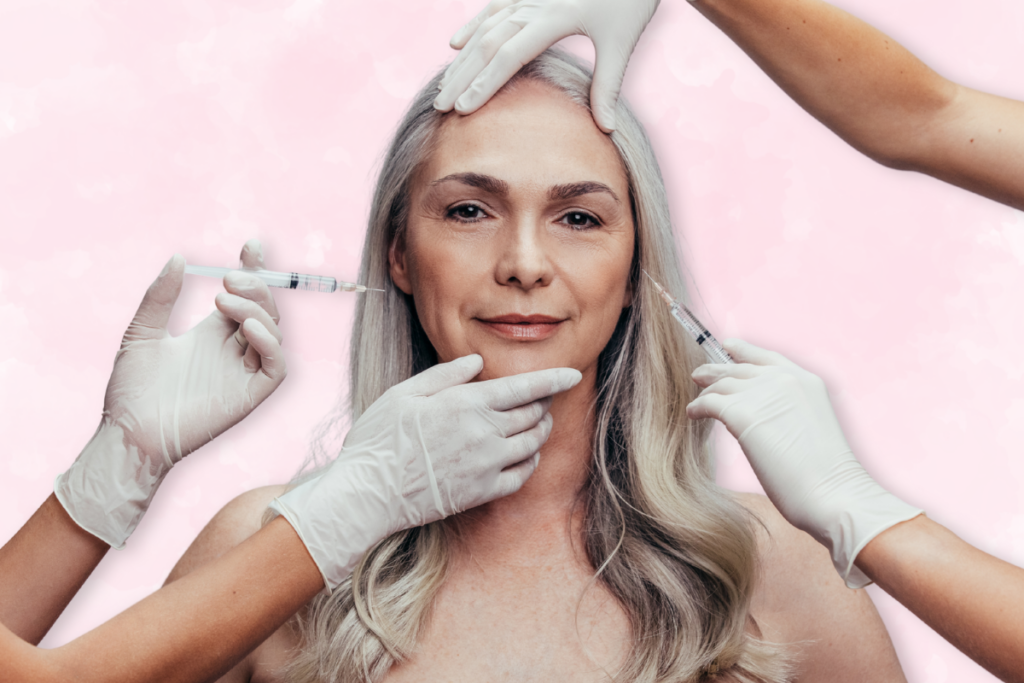You’re ready to take the plunge into powerful anti-aging treatments. The question is, which is right for you? Botox vs. fillers?
In the realm of cosmetic procedures, Botox and dermal fillers are two of the most popular options available for achieving a youthful appearance. While both are non-surgical treatments designed to reduce the signs of aging, they differ significantly in their uses, compositions, and effects.
Understanding the differences and similarities between Botox vs. fillers can help you decide which treatment is right for you.
What is Botox?
Botox, short for Botulinum Toxin, is a neurotoxic protein produced by the bacterium Clostridium botulinum. When exposed to this natural bacteria in food or through wounds, it can cause a rare but paralyzing and potentially deadly sickness called botulism.
However, cosmetic medicine only uses a sterilized and diluted version of the neurotoxin produced in a lab, making it completely safe.
When a professional injector or dermatologist injects a small, controlled dose into specific muscles, it causes a desired temporary paralysis, preventing them from contracting. This effect smooths out wrinkles and fine lines, particularly those caused by repetitive facial movements such as frowning or squinting.
Common Uses of Botox
Forehead Lines — The horizontal lines across the forehead
Glabellar Lines — Vertical frown lines between the eyebrows, often referred to as “11s”
Crow’s Feet — The lines that form around the outer corners of the eyes
Bunny Lines — The wrinkles that appear on the sides of the nose when you smile or laugh
Chin — The dimpling or lines caused by contracting chin muscles
Neck — Smoothes skin around neck muscles for a firmer, younger look

Another common and highly effective use for Botox is treating migraines and muscle spasms.
How Botox Works
Botox works by blocking the signals from the nerves to the muscles. When injected into a specific muscle, it prevents the muscle from contracting, which in turn softens and reduces the appearance of dynamic wrinkles that form as a result of repeated facial movements.
The number of Botox injections you need depends on the skin’s thickness, the muscle’s strength, and how deep your lines and wrinkles are in the treatment area.
The effects of Botox are temporary, typically lasting between three to six months. If you don’t receive additional treatment, the muscle action gradually returns, and wrinkles may reappear.
While studies are ongoing, there is anecdotal evidence to suggest that repeated Botox injections can weaken the muscles over time, making the anti-aging effects last longer.
What are Dermal Fillers?
Dermal fillers are substances injected beneath the skin’s surface to add volume and fullness.
Unlike Botox, which targets wrinkles caused by muscle movement, fillers address static wrinkles, volume loss, and facial contouring. The most common fillers contain hyaluronic acid, a naturally occurring molecule in the skin that helps retain moisture, keep the skin plump, lubricate joints, and support skin recovery after damage.
Common Uses of Dermal Fillers
- Nasolabial Folds — The lines that run from the sides of the nose to the corners of the mouth
- Marionette Lines — The lines that run downward from the corners of the mouth
- Lip Augmentation — Enhancing the size and shape of the lips
- Cheek Enhancement — Adding volume to the cheeks to create a more youthful appearance
- Under-Eye Hollows — Filling in the tear troughs to reduce the appearance of dark circles
How Dermal Fillers Work
Aestheticians and dermatologists inject dermal fillers into specific areas of the face to add volume, smooth out wrinkles, and enhance facial features. You can see the effects immediately after treatment. Depending on the type of filler used, results can last from six months to two years or more.
Hyaluronic acid fillers are the most popular because they are natural, reversible, and offer a smooth, plump finish. Other types of fillers include calcium hydroxylapatite, poly-L-lactic acid, and polymethyl methacrylate (PMMA).

Botox vs Fillers: The Differences
While both Botox and fillers combat the signs of aging, they do so in unique ways and are used for different purposes. Here are the key differences:
- Mechanism of Action:
- Botox works by relaxing the muscles that cause dynamic wrinkles, thereby reducing their appearance.
- Fillers add volume to the skin, smoothing out static wrinkles and enhancing facial contours.
- Treatment Areas:
- Botox is typically used in areas with frequent muscular movement, such as the forehead and upper face.
- Fillers are commonly used in the lower face to plump nasolabial folds, marionette lines, lips, and cheeks.
- Onset of Results:
- The effects of Botox take 3 to 7 days to appear, with full results visible in about two weeks.
- Fillers offer immediate results, with some minor swelling or bruising that subsides within a few days.
- Duration of Effects:
- Botox typically lasts between 3 to 6 months.
- Fillers can last anywhere from 6 months to 2 years, depending on the type and the area treated.
- Composition:
- Botox is made from a purified protein derived from the bacterium Clostridium botulinum.
- Fillers are primarily composed of hyaluronic acid, but other materials, such as calcium hydroxylapatite and poly-L-lactic acid, are also used.
- Reversibility:
- Botox effects are temporary and will wear off naturally over time.
- If needed, fillers made from hyaluronic acid can be dissolved using an enzyme called hyaluronidase.

Botox vs Fillers: The Similarities
Despite their differences, Botox and fillers share some commonalities that make them complementary treatments in many cases:
1. Minimally Invasive — Both Botox and fillers are minimally invasive procedures, meaning they involve little to no downtime and use injections rather than surgery.
2. Quick Procedure — They are relatively quick and often called “lunchtime procedures” because professionals can do them in 15 to 30 minutes without anesthesia.
3. Temporary Results — Neither Botox nor fillers are permanent. This is good because it allows for adjustments over time as aging progresses and patient preferences evolve.
4. Combination Use — You can use Botox and fillers together for a more comprehensive facial rejuvenation. For example, Botox can relax wrinkles on the forehead, while fillers can restore volume in the cheeks or lips. Some call this combination approach a “liquid facelift.”
5. Customization — Both treatments are highly customizable. A skilled practitioner can tailor the injections to the patient’s unique facial anatomy and desired outcomes, ensuring natural-looking results.

Botox vs Fillers: Choosing What’s Best For You
The choice between Botox and fillers depends on your individual needs and aesthetic goals.
If you are looking to smooth out dynamic wrinkles caused by muscle movement, Botox is likely the better option. On the other hand, fillers may be more appropriate if you want to restore volume, enhance facial contours, or smooth out deeper static wrinkles.
It’s also important to consider that both treatments can work together to provide a more comprehensive anti-aging solution.
Consulting with a qualified and experienced practitioner is crucial in determining the best treatment plan for your specific concerns. They can assess your skin, discuss your goals, and recommend the most suitable approach, whether it’s Botox, fillers, or a combination of both.

Look Younger Today
Botox and fillers are potent tools in cosmetic medicine. They offer incredibly effective solutions for those wanting to reduce the signs of aging.
While they serve different purposes, they complement each other in many ways. Both provide a customizable and minimally invasive approach to facial rejuvenation.
By understanding how these two treatments work and what they do, you can make an informed decision in the Botox vs. Fillers debate. Whether using them separately or together, your aesthetician will develop a plan to give you the youthful, refreshed appearance you desire.

